
Chartres Cathedral, also known as the Cathedral of Our Lady of Chartres, is a Catholic church in Chartres, France, about 80 km southwest of Paris, and is the seat of the Bishop of Chartres. Mostly constructed between 1194 and 1220, it stands on the site of at least five cathedrals that have occupied the site since the Diocese of Chartres was formed as an episcopal see in the 4th century. It is one of the best-known and most influential examples of High Gothic and Classic Gothic architecture, It stands on Romanesque basements, while its north spire is more recent (1507–1513) and is built in the more ornate Flamboyant style.

Milan Cathedral, or Metropolitan Cathedral-Basilica of the Nativity of Saint Mary, is the cathedral church of Milan, Lombardy, Italy. Dedicated to the Nativity of St. Mary, it is the seat of the Archbishop of Milan, currently Archbishop Mario Delpini.
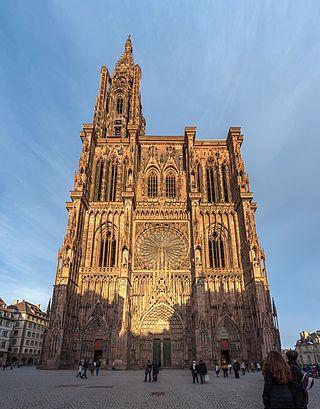
Strasbourg Cathedral or the Cathedral of Our Lady of Strasbourg, also known as Strasbourg Minster, is a Catholic cathedral in Strasbourg, Alsace, France. Although considerable parts of it are still in Romanesque architecture, it is widely considered to be among the finest examples of Rayonnant Gothic architecture. Architect Erwin von Steinbach is credited for major contributions from 1277 to his death in 1318, and beyond through his son Johannes von Steinbach, and his grandson Gerlach von Steinbach, who succeeded him as chief architects. The Steinbachs’ plans for the completion of the cathedral were not followed through by the chief architects who took over after them, and instead of the originally envisioned two spires, a single, octagonal tower with an elongated, octagonal crowning was built on the northern side of the west facade by master Ulrich Ensingen and his successor, Johannes Hültz. The construction of the cathedral, which had started in the year 1015 and had been relaunched in 1190, was finished in 1439.

The Cathedral of Saint Mary of Burgos is a Catholic church dedicated to the Virgin Mary located in the historical center of the Spanish city of Burgos. Its official name is Santa Iglesia Catedral Basílica Metropolitana de Santa María de Burgos.

The Santiago de Compostela Arch cathedral Basilica is part of the Metropolitan Archdiocese of Santiago de Compostela and is an integral component of the Santiago de Compostela World Heritage Site in Galicia, Spain. The cathedral is the reputed burial place of Saint James the Great, one of the apostles of Jesus Christ. It is also among the remaining churches in the world built over the tomb of an apostle, the other ones being St Peter's Basilica in Vatican City, St Thomas Cathedral Basilica in Chennai, India and Basilica of St. John in Izmir, Turkey.
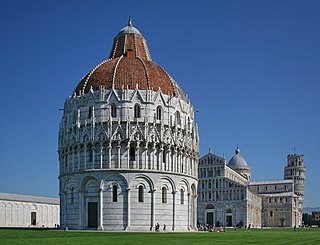
The Pisa Baptistery of St. John is a Roman Catholic ecclesiastical building in Pisa, Italy. Construction started in 1152 to replace an older baptistery, and when it was completed in 1363, it became the second building, in chronological order, in the Piazza dei Miracoli, near the Duomo di Pisa and the cathedral's free-standing campanile, the famous Leaning Tower of Pisa. The baptistery was designed by Diotisalvi, whose signature can be read on two pillars inside the building, with the date 1153.
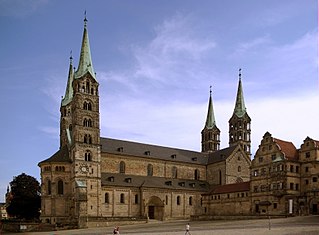
Bamberg Cathedral is a church in Bamberg, Germany, completed in the 13th century. The cathedral is under the administration of the Archdiocese of Bamberg and is the seat of the its archbishop. Since 1993, the cathedral has been part of the UNESCO World Heritage Site "Town of Bamberg".

Quimper Cathedral, formally the Cathedral of Saint Corentin, is a Roman Catholic cathedral and national monument of Brittany in France. It is located in the town of Quimper and is the seat of the Diocese of Quimper and Léon. Saint Corentin was its first bishop.
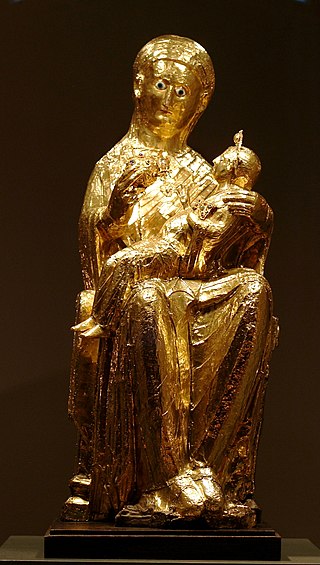
The Golden Madonna of Essen is a sculpture of the Virgin Mary and the infant Jesus. It is a wooden core covered with sheets of thin gold leaf. The piece is part of the treasury of Essen Cathedral, formerly the church of Essen Abbey, in North Rhine-Westphalia, Germany, and is kept on display at the cathedral.

A jamb, in architecture, is the side-post or lining of a doorway or other aperture. The jambs of a window outside the frame are called reveals. Small shafts to doors and windows with caps and bases are called jamb-shafts; when in the inside arris of the jamb of a window, they are sometimes called scoinsons.

The Metropolitan Cathedral of the Annunciation, popularly known as the Metropolis or Mitropoli, is the cathedral church of the Archbishopric of Athens and all of Greece.
The bliaut or bliaud is an overgarment that was worn by both sexes from the eleventh to the thirteenth century in Western Europe, featuring voluminous skirts and horizontal puckering or pleating across a snugly fitted under bust abdomen. The sleeves are the most immediately notable difference when comparing the bliaut to other female outer clothing of the Middle Ages. They fit closely from the shoulder to approximately the elbow, and then widen from the elbow to drape to floor- or nearly floor-length. This garment's usage appears to be geographically limited to areas of French influence, with some works depicting the garment or the garment in transition as far away as Rome and modern Germany.

Verona Cathedral is a Roman Catholic cathedral in Verona, northern Italy, dedicated to the Blessed Virgin Mary under the designation Santa Maria Matricolare. It is the episcopal seat of the Diocese of Verona.
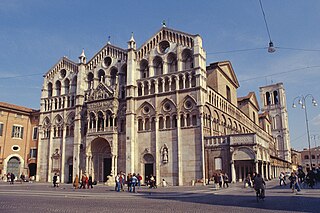
Ferrara Cathedral is a Roman Catholic cathedral and minor basilica in Ferrara, Northern Italy. Dedicated to Saint George, the patron saint of the city, it is the seat of the Archbishop of Ferrara and the largest religious building in the city.
The decade of the 1200s in art involved some significant events.
A trumeau is the central pillar or mullion supporting the tympanum of a large doorway, commonly found in medieval buildings. An architectural feature, it is often sculpted. Monolithic or paired, it becomes sculpted or decorated in Romanesque architecture, whose architectural invention consisted in animating the structure of the door, at the same time as Romanesque artists imagined compound pillars and double scrolled arcades, in the second quarter of the 11th century.

The statue of John Wesley, St Paul's Churchyard is an outdoor bronze sculpture depicting the theologian, cleric and co-founder of the religious movement known as Methodism, John Wesley. The statue is located northwest corner of St Paul's Churchyard, London, England, and was erected in 1988. It was cast from a sculpture created by Samuel Manning and his son between 1825 and 1849.

The Smiling Angel, also known as the Smile of Reims or Angel of the Annunciation, is a stone sculpture at the cathedral of Reims. Sculptors that were pioneers of the Gothic style came from workshops in Chartres, Paris and Amiens to work on the Reims Cathedral. The most striking aspect of the cathedral is its façade, particularly its Annunciation sculpture, which includes the "Smiling Angel”. The Angel was carved between 1236 and 1245. This figure is located on the right side of the north portal of the west facade.

The Portico of Glory of Santiago de Compostela Cathedral is a Romanesque portico and the cathedral's main gate created by Master Mateo and his workshop, on the orders of King Ferdinand II of León. The king donated to Mateo one hundred maravedís annually between 1168 and 1188. To commemorate its completion in 1188, the date was carved on a stone set in the cathedral and on the lintel that supports the richly ornamental tympanum. Under the contract made in 1168, if Mateo was to renege on the deal to create the portico at any time, he would have to pay 1,000 gold pieces (aureos). The complete three-piece set took until 1211 to completely finish; when the cathedral was consecrated in the presence of King Alfonso IX of León.

A statue of Queen Anne is installed in the forecourt outside the west front of St Paul's Cathedral, in London, United Kingdom. It became a Grade II listed building in 1972.
















